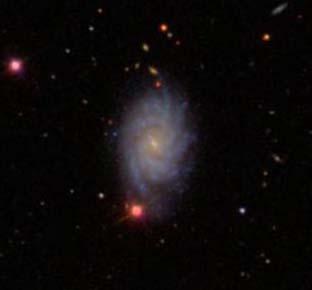
An optical image of the disk galaxy NGC 3488. Astronomers have discovered a twisted bar at the center of this galaxy.
Disk galaxies are highly flattened, roughly circular galaxies, that are shaped like a disk. Some, like our Milky Way, have majestic arms spiraling outward from their centers, while others show only a very irregular structure. About half of disk galaxies are known to have a bar in their center, a straight structure perhaps only thousands of light-years in length that is composed of stars (and sometimes gas and dust). The inner portions of spiral arms are often coincident with the outer ends of the bars. As the galaxy slowly spins the bars, like the spiral arms, rotate.
Astronomers suspect that bars are formed spontaneously in disk galaxies, and that they play an important role in the evolution of the galactic ecosystem. As the stars, gas, and dust in a spiral arm slowly rotate around the galaxy with the arms, the motion leaves the material in a roughly stable, quiescent orbit. But a bar, because it stretches straight from the inner arm into the nuclear region, can channel gas and dust out of its stable orbit into the tumultuous zone around the nucleus where it can interact with other incoming material to form new stars -- or even feed the massive black hole that likely resides at the very center. Our Milky Way has a bar, and scientists studying the development and evolution of the earth's cosmic home are keen to understand what role its bar has played. Bars are common in the universe, and understanding their general cosmic role is an equally pressing inquiry.
It is often very difficult to see a bar, much less study it, because they are relatively small and often obscured by the bright outer regions of a galaxy. SAO astronomer Jiasheng Huang, together with five colleagues, has taken advantage of the Infrared Array camera (IRAC) on the Spitzer Space Telescope to obtain images of the bar of one disk galaxy known as NGC 3488, located about 120 million light-years away. The four infrared colors of the IRAC camera can discriminate between the stars in the bars and the warm dust. The scientists report that there are two bars in this galaxy - or more precisely, one bar in which the dust component has twisted with respect to the stellar component by about 25 degrees. They suggest that it may have taken about thirty million years for new stars to form in the bar, while meanwhile the dust and gas in the bar has rotated faster than the stellar component, forming a separate structure. Such misalignments are very rare, and the authors suggest that this one may have been triggered when NGC3488 swallowed a smaller galaxy. The results may help astronomers unravel the past history of disk galaxies, and well as their possible futures.